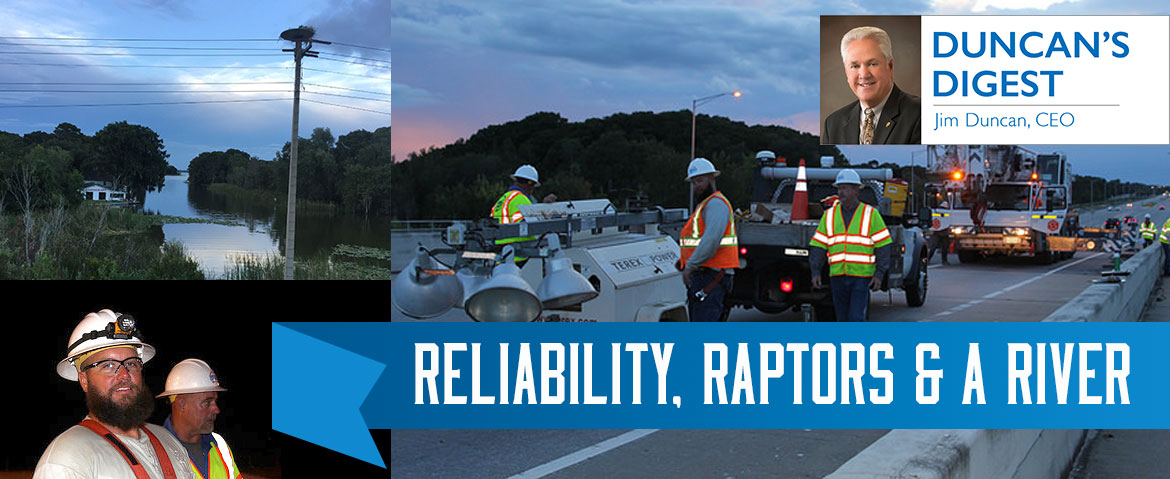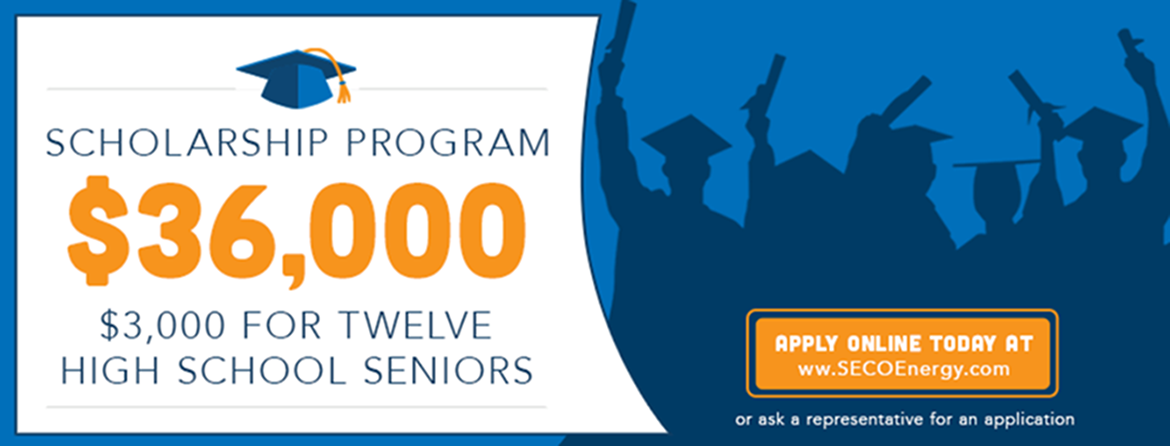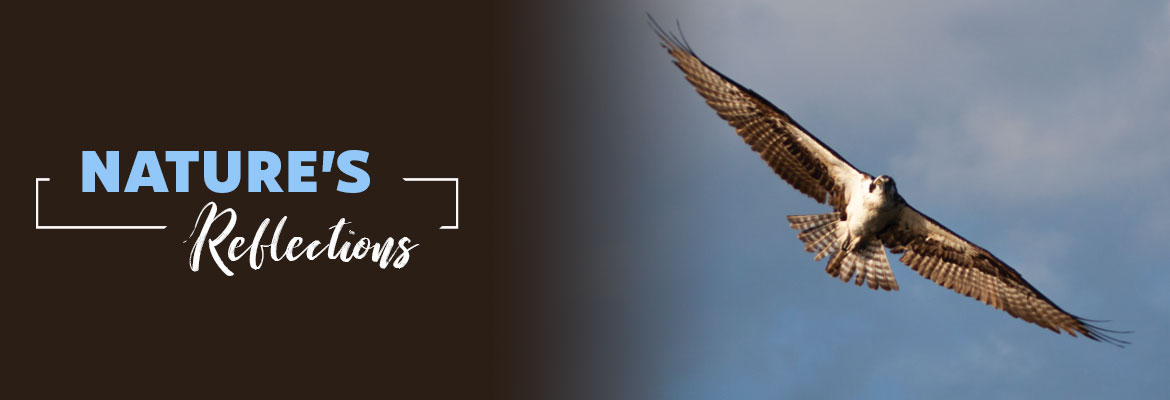Duncan’s Digest
Reliability, Raptors and a River
HAPPY NEW YEAR! 2018 marks SECO Energy’s 80th year as a not-for-profit electric cooperative in Central Florida. The cooperative has grown alongside the counties it serves, and now provides safe, affordable, reliable power to 200,000 homes and businesses.
63,000 of our 200,000 members reside in Lake County – famous for its vast number of waterways. In fact, almost 20 percent of the county is covered by water. SECO’s Operations crews responsible for building and maintaining SECO facilities must adapt to the unique watery landscape. In the past, crews sometimes installed poles and lines using the most direct route possible, spanning small bodies of water and poles were often installed in standing water.

Reminding us of by-gone construction standards, a concrete pole supporting a main feeder line rises out of Tavares’ Dead River. An osprey nesting dish at the top has offered a home for raptors inhabiting Lake County waterways. The longstanding nest on this dish was inactive and had collected years of debris. Recently, rotting debris falling off the dish made contact with the feeder line and caused an outage for 250 members. Operations crews restored power to the affected members in under an hour by temporarily rerouting (aka backfeeding) through a different feeder line.
To permanently fix the problem, we needed a complex plan. Crews would replace the damaged equipment and remove the burned debris from the nesting dish – all while suspended 45 feet above the river. Multiple support personnel would be on-site and a rescue boat would be launched in the river. Standard bucket trucks aren’t equipped for this type of job – SECO needed heavy equipment, including a 75-ton crane.
Access to the pole was limited and stationing a crane of this size near the marshy river bank was impossible. The pole would have to be accessed from the river overpass on Highway 441. With assistance from the Florida Highway Patrol and permitting from Lake County, the right two lanes were closed after 7 pm. The crane rolled in while SECO personnel set up a roadside job site. The line was grounded and de-energized for safety.
Line techs from SECO’s Eustis Operating Center – Nathan Rioux and Brandon Blackmon – volunteered to work from the crane basket suspended over the river while Sumterville line tech Logan Land observed from the rescue boat.
Before work commenced, SECO’s Safety Manager was on-site to oversee the security of the crane and basket’s connection. Nathan and Brandon donned their personal protective equipment and inspected their safety harnesses. The basket’s maneuvers were tested while empty and with the team in the basket.
Once testing was complete, the hard work began. The team replaced the damaged insulators and spliced in 20 feet of overhead conductor before installing new animal protections. The old nest debris was removed while Logan observed the work from the rescue boat below and watched for alligators and fishing boats.
The project took hours but was worth the wait and effort. The power line is reliable again, and with a cleaner, safer dish available, ospreys will soon build anew. Future plans are in the works to redesign this feeder line as an underground service. This enhancement requires a St. John’s Water Management District permit, as SECO plans to bore under the Dead River. The pole will remain in its current location to support existing communications cable and fiber lines belonging to other entities.
The pole and nesting dish will stand available for future generations of roosting osprey making their home near the river. This project is just one of many examples of SECO’s support of environmental protection.
Sincerely,
Jim Duncan
Chief Executive Officer

Home Energy Assessment – Increase Your Energy Efficiency IQ
MAKE A RESOLUTION to increase your energy efficiency IQ in 2018 and save money on your monthly energy bill with SECO’s online Home Energy Assessment, a whole-house energy audit you can complete from the comfort of your home.
SECO’s Home Energy Assessment will help you identify energy wasters. Get started by visiting our Home Energy Assessment page and input the specific details of your home and your family’s lifestyle.
In just minutes, SECO will send you an email with low-cost energy-saving tips tailored to your home. Review the energy-saving tips and implement those that best apply to your home and lifestyle. Increasing your home’s energy efficiency will decrease your energy use and ultimately lower your monthly energy bill.
For a more in-depth audit of your home’s energy wasters, SECO offers in-home energy audits at no charge. To request an on-site energy audit with one of our Energy Services Specialists, visit our website or give us a call.

2018 SECO Scholarship Program
SECO ENERGY is proud to renew its commitment to local, young scholars through its 2018 SECO Scholarship program. SECO will award up to 12 $3,000 scholarships to graduating high school seniors who live in a home served by SECO Energy. Our not-for-profit cooperative has awarded scholarships for more than 20 years, contributing over $500,000 to 250+ local students seeking higher education.
Who is eligible to apply? High school seniors graduating in the current year (May/June) who live in a home served by SECO Energy. Recipients must be enrolled full-time in an accredited college, university or vocational/technical school located in Florida by the end of 2018.
Applications are available beginning January 1 at all Member Service Centers or on our Scholarship page online. Completed applications must be received by 5 p.m. Friday, March 30, 2018. Mail the application to:
SECO Energy
Attn: Corporate Communications
P.O. Box 301
Sumterville, FL 33585
Applications can also be delivered to a Member Service Center. If you have questions, email Communications@secoenergy.com or call (352) 569-9561. Winners will be notified by phone or mail in late April.
Correction
In December SECO News, January’s Board of Trustees Meeting date was incorrect. The correct date of January’s Board Meeting is January 29, 2018.
Read the full January 2018 SECO News here.







